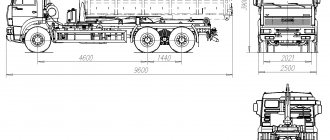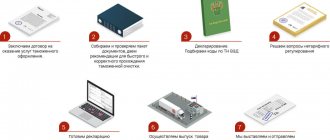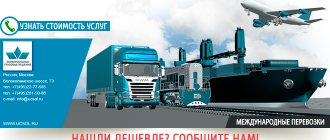Any product crossing the borders of the Russian Federation is subject to customs control. This rule of law also applies to vehicles, regardless of their type, class, purpose and method of import into the country.
Customs clearance of vehicles is a mandatory multi-stage procedure, which includes placing a car purchased abroad for any purpose under the customs regime and carrying out measures to legalize it. Registration of a car purchased abroad is possible only after completing the customs clearance procedure and paying all required payments.
Stages of customs clearance
The obligation for customs clearance of goods, as well as vehicles, arises as a result of their movement or “customs clearance”, in the manner established by the Customs Code of the Russian Federation (hereinafter referred to as the Labor Code of the Russian Federation) and other regulations. Customs clearance is a set of customs operations and procedures for placing goods, as well as vehicles, under the established customs regime, as well as completing the specified regime.
The concept of “customs clearance” is disclosed as the totality of all customs operations and procedures carried out in relation to the declared goods during the period when they are directly at the stage of customs control, up to the moment these goods and vehicles acquire permanent status for customs purposes.
The participants in the customs clearance procedure are:
- declarant, customs broker (if the declarant uses the services of a customs broker);
- carrier;
— customs carrier (if he is involved in the process of transporting goods at the stage of customs control);
— customs authority (customs or customs post).
Customs clearance consists of individual customs operations and customs procedures provided for by the Labor Code of the Russian Federation. The set of customs operations and procedures necessary to carry out customs clearance constitutes the content of customs clearance. Individual customs operations and customs clearance procedures are called stages of customs clearance. The customs legislation of the Russian Federation provides for the following stages of customs clearance (subsection 1 of section II of the Labor Code of the Russian Federation):
1) arrival of goods directly into the customs territory of the Russian Federation;
2) internal customs transit;
3) temporary storage;
4) declaration of goods;
5) release of goods;
6) departure of goods from the customs territory of the Russian Federation.
The number and sequence of stages of customs clearance depends on the direction of movement of goods and their status. Firstly, the stages of internal customs transit and temporary storage are provided for customs clearance of foreign goods only. Secondly, the stage of internal customs transit is optional (it may not be carried out). Internal customs transit is used when transporting goods from the territory of their arrival to the location of the customs authority of destination, from the place of actual location of goods in the process of their declaration to the place of their movement from the customs territory of the Russian Federation, between temporary storage warehouses, customs warehouses, in addition in other cases of transportation imported goods within the territory of the Russian Federation, in the case where there is no security for customs duties for these goods.
Concept and meaning
As part of the definition of this concept, it is worth noting that customs documents are the papers required to formalize the movement of goods across the border. In modern society, these tools are all provided for by the legislation of the Russian Federation, regulations, and, in addition, the Customs Code. Their meaning is as follows:
- Movement of goods across borders.
- Application of a certain customs regime.
- Production control and registration.
- Collection of payments.
- Other customs and statistical purposes.
Temporary storage
The temporary storage stage is an optional stage of customs clearance. Placing goods in temporary storage warehouses is not required if customs clearance of goods is completed within one day after presentation of the goods to the customs authority of the Russian Federation, provided that these goods are under constant customs control and accounting of goods by the owner of a nearby temporary storage warehouse.
In this case, we are not talking about the entire customs procedure, called “temporary storage,” but only about one action included in this procedure - the actual placement of goods in a temporary storage warehouse.
From the requirements of paragraph 2 of Art. 77 of the Labor Code of the Russian Federation, we can conclude that temporary storage is a mandatory stage, and the placement of goods in a temporary storage warehouse can be actual or formal. According to paragraph 2 of Art. 77 of the Labor Code of the Russian Federation, upon presentation of goods at the point of their arrival, the status of those goods being in temporary storage from the moment of arrival is established in relation to these goods.
Contract
A foreign trade contract is drawn up in English and Russian, indicating the main language understandable to both parties. This is the basic commercial business paper of the transaction.
The structure of a foreign trade contract includes:
- Terms of the transaction;
- Rights, responsibilities and obligations of participants;
- Timing and cost;
- The process of pre-trial conflict resolution;
- Details of the parties.
Additional agreements are also drawn up in two languages, they indicate:
- cargo information,
- its quantity,
- total cost,
- price for each unit of goods.
In addition The agreement specifies the payment procedure and terms of production of products.
Financial documents
Papers required for conducting foreign economic activity:
- Invoice is the basis for payment;
- Proforma invoice - it indicates the price of the goods transported. Proforma is required to confirm customs value and pass through customs control;
- Certificate of country of origin - issued by the customs chamber of the country of export.
The company must also:
- balance sheet,
- financial flow report,
- financial securities that reflect payment and banking transactions.
The head of the company and the chief accountant usually have the right to sign financial documents.
Payment documents
Foreign economic activity is accompanied by the execution of payment papers, which confirm the fulfillment of the terms of the contract and guarantee compliance with obligations. Their list depends on the procedure and should be clarified in advance.
Main types of payment documents:
- Payment order - issued by the owner of the bank account, the document is necessary for conducting monetary transactions;
- An extract from a personal account is needed to confirm the transfer of funds and the execution of payments;
- Tax receipts;
- Bank statements;
- Deposit - is issued when making an advance payment.
Customs clearance procedure
The customs clearance procedure can be general (the usual customs clearance procedure) or simplified (for the import or export of goods crossing the customs border of the Russian Federation, used to eliminate the consequences of natural disasters, accidents or catastrophes, as well as goods with a short shelf life, live animals , radioactive materials, international postal items and some other goods) and special (customs clearance, which involves the implementation of sanitary-quarantine, veterinary, phytosanitary, as well as other types of control by the state in relation to transported goods).
Customs clearance is carried out on the territory of the location of customs authorities and during the period of operation and operation of these authorities. Customs operations for customs clearance are carried out by officials of the customs clearance and customs control department of the customs office or officials of the customs post.
At the reasoned request of the declarant or other interested party (carrier or customs broker), part of the customs operations during the customs clearance process may be carried out not on the territory of the location and not during the working hours of the customs authorities, subject to compliance with the rules of the Labor Code of the Russian Federation.
For customs clearance, customs duties are charged in amounts determined by the Government of the Russian Federation.
Certificate of examination of commodity origin
This paper is issued by the competent authority (usually the commodity examination department of the Chamber of Commerce and Industry) at the request of the manufacturer. It contains information about the origin of components and raw materials, the number and date of the contract for the supply of these products. Among other things, it lists the main process operations that were performed at the enterprise. In their conclusion, the experts testify that the product actually originates from this country. Based on the relevant examination report, a certificate of origin is issued.
Registration deadlines
In Art. 60 of the Labor Code of the Russian Federation determines the start and end of customs clearance. The timing of the customs clearance procedure is not fixed in the Labor Code of the Russian Federation, however, the duration of the customs clearance procedure is directly affected by two deadlines provided for by the Labor Code of the Russian Federation: the deadline for filing a customs declaration (Article 129) and the deadline for releasing goods (Article 152). The deadline established by customs legislation for filing a customs declaration in respect of goods imported into the territory of the Russian Federation is 15 days. The starting point for the deadline for filing the declaration is the day of presentation of the goods specified in the declaration to the customs authorities at the place of arrival of such goods on the customs territory of the Russian Federation, or the day of completion of internal customs transit is recognized as such moment, in cases where the declaration of goods is made in a place other than their place arrival. This rule applies if the procedure for releasing goods was not applied before submitting the customs declaration. Other deadlines are provided for customs clearance in relation to goods imported by individuals in hand luggage or accompanied luggage, as well as goods sent by international mail. Customs authorities complete the customs clearance procedure by making a decision on the release of goods, which must be properly formalized within no more than three working days from the moment the customs authorities accept the customs declaration and submit any other necessary documents and information, as well as the actual presentation of the goods to the customs authorities .
The release of goods by the customs authority is the result of an inspection of the provided customs declaration, as well as other documents and declared goods as a result of their customs clearance. The maximum period for such verification is established by Art. 359 of the Labor Code of the Russian Federation and is equal to three working days. The inspection period may be extended by the customs authority for the time required by the person authorized with respect to the declared goods in order to divide the specified consignment into individual goods. Extending the inspection period automatically extends the period for the release of goods, and therefore lengthens the duration of the customs clearance procedure.
Currency license and cargo declaration
This is a document issued by a competent authority authorizing the importer-buyer to transfer a certain amount to the exporter-seller in foreign currency in payment for the product.
A cargo declaration is sometimes called a freight declaration. This is a general term that refers to documents that contain the necessary data for customs regarding cargo transported by commercial means of transport. This customs transport document is drawn up according to the model adopted by the Convention for Facilitation of International Maritime Shipping as a basic document that contains information on products required by government authorities as part of the arrival or departure of the ship.
Declaration
The main stage of customs clearance is the declaration of goods. Goods are subject to mandatory declaration to customs authorities provided they are moved across the customs border of the Russian Federation, a change in the customs regime, as well as in other cases provided for in Art. Art. 183, 184, 247, 391 Labor Code of the Russian Federation.
Customs clearance, including filling out the necessary documents, as a general rule, is carried out in Russian. At the same time, the Labor Code of the Russian Federation also provides for exceptions to this rule (Article 65). Customs authorities may accept and use for customs purposes duly certified documents, as well as information prepared in those foreign languages spoken by officials authorized by customs authorities. In world practice, two methods of approval and certification of such foreign documents are most often used: 1) through consular legalization; 2) by affixing an apostille.
Declaration (from the Latin declaratio - statement, announcement) - a statement to the customs authority in the established form of information about transported goods and vehicles necessary for customs purposes.
Declaration is made by the declarant or a customs broker at the choice of the declarant.
The Labor Code of the Russian Federation provides for four forms of declaration:
- oral;
- written;
— electronic;
- conclusive.
In non-trade transactions (during customs clearance of hand luggage and passenger luggage), declarations are used in written, oral or implicit form. An example of a declaration in a conclusive form is the passage of passengers at international airports along the “green corridor”. In this case, the passenger, by his action, declares to customs officials that he does not have goods when crossing the border, which are subject to mandatory written declaration.
In trade turnover (during customs clearance of goods transported for commercial purposes), declarations are used in written and electronic forms. Today, there are cases where Russian customs authorities accept goods for customs clearance only in the electronic form of a cargo customs declaration.
The main document for declaration is the customs declaration. The following types of customs declarations are distinguished:
1) complete;
2) incomplete (Article 135 of the Labor Code of the Russian Federation);
3) temporary (Article 138 of the Labor Code of the Russian Federation);
4) periodic (Article 136 of the Labor Code of the Russian Federation).
The declarant has the right to submit a customs declaration to any customs authority that has the authority to accept the customs declarations provided. In order to ensure the greatest efficiency of control over compliance with the established customs legislation of the Russian Federation, the Ministry of Economic Development and Trade of the Russian Federation may determine the specialization of individual customs authorities in the cases provided for in paragraph 2 of Art. 125 Labor Code of the Russian Federation. When submitting a customs declaration to a customs authority that cannot carry out customs clearance of this product, the customs declaration on the day of its submission is sent to the authorized customs authority. The established period for accepting a customs declaration in this case must be extended by the time necessary to carry out the procedure for its forwarding, but such a period cannot be more than two working days.
A customs declaration in respect of goods crossing the border and imported into the customs territory of the Russian Federation is submitted no later than 15 days from the date of actual presentation of such goods to the customs authorities at the place of arrival of such goods into the customs territory of the Russian Federation or from the moment of completion of the internal customs transit procedure, in the case when the declaration of the specified goods is carried out in a place other than the place of their arrival. However, there are exceptions to this rule as listed below.
If such a period is not enough for the declarant to collect the documents and information established by customs legislation, based on a reasoned request of the person declaring the goods in writing, the customs authority has the right to extend the period for filing a customs declaration. At the same time, it should be taken into account that the extension of the deadline for filing a customs declaration should not entail a violation of the period established for the temporary storage of goods. If the end of the established deadline for filing a customs declaration falls on a day that is not a working day of the customs authority, the working day following this day should be considered the end of this period.
When importing into the customs territory of goods used for the purpose of eliminating the consequences of natural disasters, accidents and catastrophes, as well as goods with a short shelf life, live animals, radioactive materials, international mail and express cargo, information messages and other materials intended for media and other similar goods, the procedure for customs clearance of such goods is carried out in a simplified form, with the establishment of the order of their priority and, in addition, using special simplified procedures for their customs clearance.
A customs declaration filled out in relation to goods exported outside the customs territory of the Russian Federation must be submitted before the departure of such goods from the customs territory of the Russian Federation, the only exception here is the cases of import/export and declaration of goods belonging to the category of goods transported through the use of power lines .
The Customs Code of the Russian Federation also provides for the institution of preliminary declaration. Any interested person can contact the customs authority by submitting a customs declaration 15 days before the import of goods (if the goods are declared at the place of their arrival) or the completion of the internal customs transit regime for them. If, after filing a customs declaration, the goods specified in it are not presented to the customs authority within 15 calendar days, then such a declaration will be considered not accepted. A customs declaration in respect of imported goods can be made even before the arrival of such goods into the customs territory of the Russian Federation or until the completion of the internal customs transit regime.
If for customs operations there is a need to use transport or other business documents accompanying the declared goods, the customs authority in the process of preliminary declaration of such goods has the right to accept copies of such documents, certified in the prescribed manner, and, if necessary, upon the actual arrival of these of goods into the territory of the Russian Federation compares the information specified in previously provided copies with the original documents.
Upon completion of the verification of the customs declaration and payment of the amounts of customs duties and taxes established by customs legislation before the arrival of the declared goods on the customs territory of the Russian Federation, the accepted customs declaration can serve as the basis and be used as a single document used in the process of customs procedures.
Import and export licenses
These categories are documents issued by state special services in the event of import and export in the country, as well as control over the export and import of goods. These papers are provided on the basis of an application from the relevant exporters or importers submitted to the authority that is responsible for issuing licenses directly in their country. They are drawn up on a special form, which consists of two parts: the application itself and the permit. It is submitted within a certain period before the expected shipment or receipt of products. The second part of the document is stamped by the issuing organization.
The content of such a customs document presupposes the availability of information about the name of the applicant, the manufacturer, seller and buyer of the goods, the type of license, the number of the permit to issue it, and the validity period of the permit. In addition, it is important to indicate the nature of the transaction along with the currency of payment, the name and full characteristics of the goods, and the name of the country where the goods are exported or imported. Additionally, data is entered on the price of each item, the period of readiness for shipment and arrival, and, in addition, the name of the authority that issued the document. It is provided for a certain period, after which it becomes invalid.
An export license is a document containing permission to export the goods listed in it for a certain time. An application for issuance of relevant documentation is a claim for obtaining permission to export specific goods of a certain value to specified destinations.
An application for an import license is a document in which interested parties ask the competent authorities to allow the import of goods, it describes in detail the type of product, its origin and cost, etc. An import license is a customs document issued by the competent authority in accordance with the rules in force, whereby the named party is granted permission to import a limited or unlimited number of such goods over a specified period of time under the specified conditions in the document.
Customs Broker
Participants in the procedure for customs declaration of goods can be either the declarant himself or a customs broker (if the declarant has used his services to participate in customs clearance).
Declarant is a person (individual or legal) who declares goods or a person on whose behalf these goods are declared. The legal status of the declarant is enshrined in Art. Art. 126 and 127 of the Labor Code of the Russian Federation.
A customs broker is an intermediary organization that carries out customs procedures and operations established by law on behalf of and on behalf of the declarant or another person who is legally entrusted with the obligation or who is granted the right to carry out customs procedures and operations. It can only be a Russian legal entity included in the Register of Customs Brokers (Representatives). The legal status of a customs broker is defined in Art. Art. 139 - 145 Labor Code of the Russian Federation. The customs declaration form is directly filled out by a customs broker employee - a customs clearance specialist.
Customs clearance specialist is an individual who has special knowledge in the field of customs clearance of goods and is included in the staff of a customs broker. The qualifications and special knowledge of a customs clearance specialist must be confirmed by the appropriate qualification certificate issued by the Federal Customs Service of the Russian Federation. The program for conducting a mandatory qualification exam for specialists in the field of customs clearance is approved by the Ministry of Economic Development and Trade of the Russian Federation. The legal status of a customs clearance specialist is established by Art. Art. 146 - 148 Labor Code of the Russian Federation.
gas turbine engine
The main document for customs clearance of goods transported for commercial purposes across the customs border of the Russian Federation (in trade turnover) is the cargo customs declaration (hereinafter referred to as the CCD).
The customs declaration is an official document drawn up in the prescribed form and used to perform customs formalities when moving goods across the customs border of the Russian Federation and when changing the customs regime under which the goods were placed. The form of the customs declaration, which was introduced into the practice of customs clearance of goods in Russia on April 1, 1989, coincides with the form of the EAD - the Unified Administrative Document used in the countries of the European Union. The forms of customs declaration forms have changed several times. Currently, the forms of customs declaration forms approved by Order of the Federal Customs Service of Russia dated August 3, 2006 N 724 are used.
Filling out the columns and sections of the customs declaration is carried out in accordance with the Instructions defining the procedure for filling out the cargo customs declaration and transit declaration, approved by Order of the Federal Customs Service of Russia dated September 4, 2007 N 1057.
Information in the customs declaration is entered by the declarant (if the declarant is an individual) or an authorized person of the declarant (if the declarant is a legal entity) or a customs clearance specialist of a customs broker (if the declarant uses the services of a customs broker). To fill out the appropriate columns of the customs declaration, for which the use of classifiers is necessary, these persons must use the annexes to the Order of the Federal Customs Service of Russia dated August 21, 2007 N 1003 “On classifiers and lists of normative and reference information used for customs purposes,” as well as the All-Russian Classifier of Countries world, approved by the Resolution of the State Standard of Russia of December 14, 2001 N 529-st, and the All-Russian Classifier of Currencies, which came into force with the adoption of the Resolution of the State Standard of Russia of December 25, 2000 N 405-st.
One customs declaration is filled out for each consignment of goods, in the event that the same customs regime is established for such goods. In the event that goods are subject to placement under different customs regimes, it is necessary to fill out the number of customs declarations that will correspond to the number of the specified regimes.
In the process of declaring goods using only the main sheet (TD-1 or TD-3), the customs declaration may contain information about goods of the same trade name, type and brand, classified by one ten-digit code in accordance with the Commodity Nomenclature of Foreign Economic Activity of the Russian Federation (hereinafter - Commodity Nomenclature of Foreign Economic Activity of Russia), the place of origin of which is one country, or if the country of origin of such goods is unknown, are subject to the same customs duties and declared under the same customs regime.
Both types of additional sheets (TD-2 or TD-4) make it possible to additionally declare goods of three more nomenclature names, types and brands, each of which is classified by one ten-digit code corresponding to the Commodity Nomenclature of Foreign Economic Activity of Russia, originates from the same country, or the country of origin of these goods is unknown , are subject to the same customs duties. The number of additional sheets to one gas turbine declaration is not limited. Additional sheets are an integral part of the customs declaration. If, when using sheets TD-2 and TD-4, there are blank columns intended for declaring one product name, then these columns must be crossed out.
In the cargo customs declaration, several information blocks, or sections, of the customs declaration can be distinguished:
a) general characteristics of the delivery (columns 1, 3 - 6): these columns contain information about the customs regime, the number of goods and packages;
b) persons involved in customs clearance (columns 2, 8, 9, 14, 54): information about the sender, recipient of goods, the person responsible for financial settlement (contract holder), as well as the declarant and the person who filled out the customs declaration is declared here;
c) geographical block (columns 11, 15 - 17a, 34): this block reflects the codes of the trading country, the country of departure and the country of origin of goods when importing goods into Russia, the country of destination - when exporting goods from Russia;
d) transport block (columns 18, 19, 21, 25, 26): information about the vehicles on which goods were transported and the use of container transportation is indicated;
e) financial block (columns 12, 20, 22 - 24, 28, 47, 48): information on the total customs value of goods declared in one customs declaration is declared; about the terms of delivery; about the code and exchange rate; banking information about the person responsible for the financial settlement; information on the calculation of customs duties;
f) the characteristics of each product in the batches are given in columns 31 to 46: these columns indicate the name of the product; its packaging; number of containers; series, numbers and number of excise stamps, etc.; ten-digit product code according to the HS of Russia; net and gross weight of the goods; customs duty exemption code; the balance of the quota, if quantitative or cost restrictions are legally established for goods in case of import; the name and number of the last issued customs document accepted by the customs authority in the prescribed manner as a result of the placement of goods under the customs procedure preceding the submission of the customs declaration; quantity of goods in an additional unit of measurement and code of an additional unit of measurement; invoice, customs and statistical value of goods.
Of particular importance is column 44 of the customs declaration, which contains a list of information and documents necessary for customs clearance of each product. This includes: the number and date of issue of the license, if the product is subject to non-tariff regulation measures; number of the transport (shipment) document; number and date of conclusion of an international purchase and sale (exchange) agreement or other agreement or contract concluded for the purpose of completing a foreign economic trade transaction; numbers and dates of invoices for payment and delivery of goods; number and date of issue of the permission of the customs authority on the classification of goods that comply with the norms of the Commodity Nomenclature of Foreign Economic Activity of Russia; numbers and dates of issuance of the necessary permits (certificates, permits, etc.); number and date of the certificate of origin of goods; numbers and dates of preparation of other documents.
Declaration of foreign exchange control for export and import
When exporting, such a paper is a document that is filled out by the exporter-seller, with its help the competent authority is able to control the transfer into the country in foreign currency of the amount received as a result of trade transactions, in accordance with the payment terms and applicable exchange control regulations.
When importing, the declaration is filled out by importers-buyers, who are the controlling party in the implementation of trade transactions for which foreign currency is allocated, and money is transferred in accordance with the terms of payment and the current exchange control rules.









